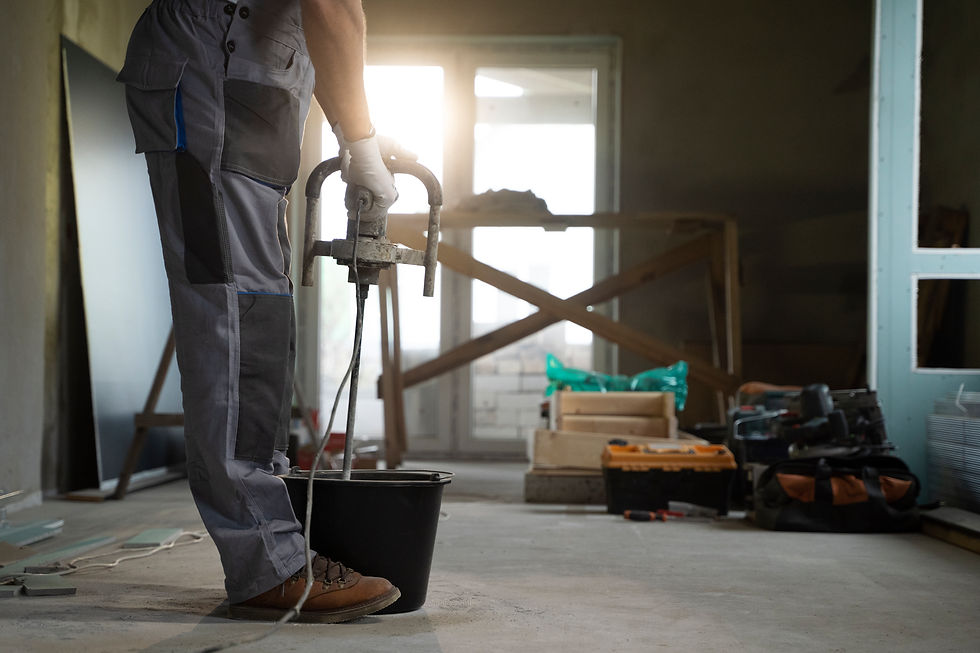A Beginner’s Guide to Installing a Sump Pump in a Finished Basement
- Adam Basement

- 1 day ago
- 4 min read

Let me guess—you’ve just finished turning your basement into a Pinterest-worthy guest suite, cozy movie den, or kid-friendly hangout. And now you hear a faint dripping or notice a suspicious damp patch in the corner. Cue panic.
Relax. I’m Adam Basement, your basement's new best friend. I’m here to help you protect that beautiful space with a guide to installing a sump pump in a finished basement that won’t sound like it came from a plumbing textbook.
And if you’re new to this whole sump pump thing, don’t worry—this beginner-friendly guide has your back.
Installing a Sump Pump in a Finished Basement: Why Your Finished Basement Needs a Sump Pump
Look, I get it. Installing a sump pump doesn’t exactly scream "home upgrade excitement." But trust me—it’s one of the smartest, most protective moves you can make for any finished basement.
Here's why:
Finished basements are expensive. Carpet, drywall, furniture—you've invested.
Water damage is sneaky and devastating.
Insurance may not always cover basement floods (read that fine print).
Peace of mind is worth its weight in sump pump gold.
A sump pump ensures that any unwanted groundwater gets sent packing before it invades your space.
Step One: Smart Placement & Drainage Considerations

How to install a sump pump? Before you start drilling into your new floors, let’s talk logistics.
Where Should It Go?
Low point of the basement: Water follows gravity, so you want the sump pit where water naturally collects.
Near an exterior wall: Makes drainage easier.
Away from finished features: Keep it clear of walls with electrical outlets, finished flooring, or anything fancy.
Drainage Must-Haves:
Properly sloped discharge line to carry water away from your foundation.
A check valve to prevent backflow.
Ideally, connect to a French drain system or interior perimeter drain.
No drainage plan = no bueno. Water needs somewhere to go, and fast.
Step Two: Submersible vs. Pedestal Pumps
This part’s important because your sump pump choice affects performance and aesthetics. Let’s break it down:
Submersible Pumps
Sits inside the sump pit, fully submerged.
Quieter and more powerful.
Takes up less visible space.
Slightly pricier.
Pedestal Pumps
Motor sits above the sump pit.
Easier to maintain (no digging down).
Louder and more noticeable.
Less ideal for finished basements (unless hidden well).
My take? For finished spaces, go with a submersible. It’s discreet, quiet, and blends into the background.
Step Three: Beginner-Friendly Sump Pump Installation Tips

Ready to get your hands a little dirty? Here’s a high-level walkthrough.
Tools You’ll Need:
Jackhammer or concrete saw (for the pit)
Shovel
Sump basin
Gravel
PVC pipe and fittings
Check valve
Sump pump (obviously)
Silicone sealant
Wet/dry vacuum
Step-by-Step Sump Pump Installation Guide:
Pick the location (see Step One).
Break through the concrete and dig a hole deep enough for the sump basin.
Add a gravel base to improve drainage.
Place the sump basin and backfill around it with gravel.
Install the pump into the pit according to the manufacturer's instructions.
Connect the discharge pipe to route water outside and away from the house.
Seal up the concrete around the basin edge.
Install the check valve on the discharge pipe.
Test it with a bucket of water to make sure it activates.
Safety Tip:
If you’re not 100% confident using power tools or messing with plumbing, consider getting a pro. (More on that in a second.)
Step Four: Make Your Finished Basement Sump Pump Pretty (or at Least Less Ugly)
You’ve got a finished basement, so the last thing you want is an industrial-looking pump sticking out like a sore thumb.
Concealment Ideas:
Install a flush, removable lid with a sealed edge.
Build a decorative enclosure or bench over it.
Place it inside a utility closet with soundproofing.
Just make sure you leave room for access and airflow. Don’t hide it so well you can’t reach it in a hurry.
Step Five: When It’s Time to Hire a Pro

Sometimes, you simply shouldn’t just DIY your sump pump for a finished basement.
⚠️ Call in the pros if:
You’re working with complex drainage systems.
There’s existing water damage or mold.
Electrical work is involved.
Your basement floor is thicker than average or has radiant heat.
Hiring a professional ensures that everything’s done up to code and that your warranty (for both pump and basement) stays intact.
Pro Tips for Installing a Sump Pump in a Finished Basement for Long-Term Success
Even the best sump pump is only as good as its maintenance plan.
Here are a few things I always remind my clients:
✔️ Test your pump quarterly. Pour water into the pit and make sure it activates.
✔️ Clean the pit annually. Gunk happens.
✔️ Install a battery backup. Power outages are prime flooding times.
✔️ Replace your pump every 7-10 years. Like tires, they wear out.
✔️ Keep discharge lines clear. Frozen or clogged lines = bad news.
Let’s Wrap This Up (Before Your Basement Floods)
There you have it, folks—a beginner’s guide to installing a sump pump in a finished basement that doesn’t require a plumbing degree or YouTube rabbit hole. Whether you’re DIY-ing it or hiring it out, just know you’re doing one of the smartest things you can for your home.
Still feeling unsure? That’s okay.

Let Adam Basement Help You Stay Dry
Here at Adam Basement, we don’t just install sump pumps—we help homeowners protect their peace of mind. Whether you need a quick consult, a full install, or just someone to double-check your setup, we’re here for you.
Call now to schedule a FREE assessment. Because your finished basement deserves to stay that way—dry, beautiful, and totally panic-free.
Until next time, stay confident and waterproofed.




Comments